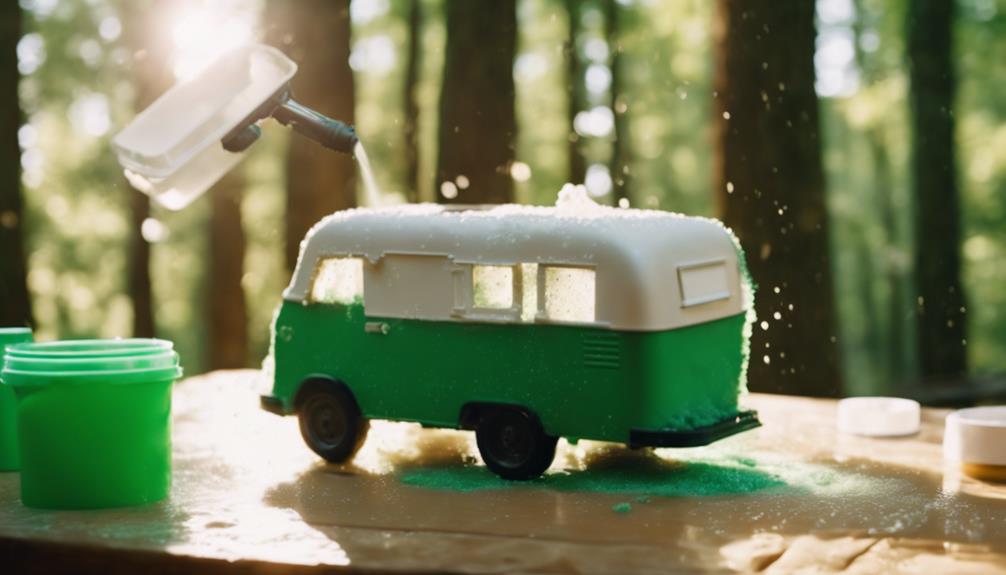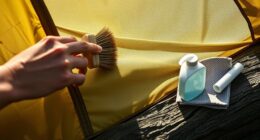To patch your pop-up camper canvas, start by inspecting the damage and measuring it accurately. Clean the area around the tear thoroughly, then trim any frayed edges for a smooth surface. Use a canvas repair kit, applying adhesive to both the patch and the canvas. For larger tears, stitch the patch securely after the adhesive sets. Let it cure undisturbed for at least 24 hours. Regular maintenance, like checking for mold and waterproofing treatments, will keep your camper in top shape. Curious about more detailed steps and tips? You'll find plenty of useful insights ahead!
Key Takeaways
- Inspect the canvas thoroughly for tears, rips, or weak spots before beginning any repair process.
- Clean the damaged area with soap and water, and trim any frayed edges for a neat repair.
- Use fabric adhesive for small rips, and for larger tears, apply patches slightly larger than the damage, secured with adhesive and stitching.
- Allow at least 24 hours for the adhesive to cure undisturbed to ensure the patch adheres properly.
Tools and Materials for Repair
To successfully patch your pop-up camper canvas, you'll need a reliable canvas repair kit that includes waterproof materials and strong adhesives. A thorough kit, like the Attwood Corporation Canvas Repair Kit, provides all the essentials for effective canvas repair.
Start with a heavy-duty needle, such as one from a Speedy Stitcher Sewing Awl, which guarantees strong stitching for larger rips. You'll also want to use durable thread—polyester or nylon works best—to make certain your patches hold up over time.
A basic measuring tool is vital for accurately evaluating the size of tears, allowing you to determine the appropriate patch size for repairs.
For smaller damage areas, fabric adhesive can offer a quick fix. However, it's important to combine this with other repair methods for the best results.
With these tools and materials at your disposal, you'll be well-equipped to tackle any canvas repair needed on your pop-up camper.
Assessing the Damage
Start by thoroughly inspecting the entire canvas for any tears, rips, holes, or weak spots, as early detection is essential for effective repairs.
Carefully examine each section, ensuring you don't miss any small damages that could worsen over time. Measure the size and location of each damage accurately; this will help you determine the appropriate patch size and repair method needed to repair the canvas.
While you're inspecting, keep an eye out for signs of mold or mildew, as these can compromise the integrity of the canvas. If you spot any, you'll need to address these issues with cleaning before you proceed with repairs.
Document the overall condition of the canvas by taking photographs of the damage. This visual record can be invaluable for future reference and maintenance, helping you track repairs and assess recurring issues.
Preparing the Canvas

Cleaning the area around the tear with soap and water is essential for guaranteeing a strong bond during the patching process. You'll want to make certain the canvas is completely dry before you start any repairs to promote better adhesion.
Here are some steps to prepare your torn canvas effectively:
- Trim any frayed edges around the damaged area for a neat repair.
- Lay the canvas flat to eliminate additional stress on the fabric.
- Protect surrounding areas from adhesive or paint by using masking tape or plastic sheeting.
- Confirm the canvas is fully opened for proper drying after repairs.
Taking these steps not only makes it easier to repair torn canvas but also helps prevent further tearing during the patching process.
Repair Techniques Overview
Patching a pop-up camper canvas involves a few effective techniques tailored to the size and type of damage you're facing. Start by cleaning the damaged area thoroughly with soap and water, guaranteeing it's completely dry before applying any adhesive or patches. For small rips, fabric adhesive works well, while larger tears need a patch that's slightly larger than the damage. Secure it with both adhesive and heavy-duty stitching to guarantee longevity.
Here's a quick overview of techniques:
| Damage Size | Recommended Repair Method | Additional Tips |
|---|---|---|
| Small Rips | Use fabric adhesive | Apply evenly to avoid lumps |
| Medium Tears | Patch with adhesive and stitch | Cut patch larger than the tear |
| Large Tears | Use heavy-duty repair tape | Guarantee edges are sealed |
| High-Stress Areas | Heavy-duty stitched patches | Use a strong, waterproof thread |
Patch Application Methods

When you're ready to apply your patch, it's vital to prepare the surface properly for the best results.
You'll want to explore different patch application techniques that suit the size of your damage and ascertain a strong bond.
Don't forget to factor in drying and curing time to assure your repair lasts.
Surface Preparation Essentials
Preparing the surface around the tear is essential for guaranteeing a strong and lasting patch. By taking the time to properly prepare, you'll enhance the adhesion of the patch on the canvas of your tent, making the repair more effective.
Here are the steps you should follow:
- Clean the area: Use soap and water to thoroughly clean the area around the tear. Make sure it's completely dry before proceeding.
- Trim frayed edges: Carefully cut away any frayed edges of the damaged canvas. This creates a neat surface and helps prevent further tearing.
- Choose the right patch: Select a patch material that's slightly larger than the tear. This guarantees full coverage and secure adhesion on all edges.
- Apply adhesive evenly: Spread adhesive evenly on both the patch and the canvas surface. This prevents excess glue from beading up and compromising the repair.
Patch Application Techniques
To achieve a strong and lasting bond, apply the patch with even pressure and make sure it's securely adhered to the canvas.
Start by cleaning and drying the damaged area thoroughly, as this step is essential for strong adhesion. Cut your patch material slightly larger than the tear, ideally in oval or circular shapes; this shape helps enhance adhesion and reduces the risk of peeling at the edges.
Next, select a heavy-duty adhesive like Tear Mender or Gorilla tape. Apply the adhesive evenly on both the patch and the canvas to guarantee peak bonding strength.
Once you place the patch, press it firmly in place. To keep it secure while the adhesive sets, consider using a weight, like a 2×4, to hold it down. This technique helps prevent shifting or bubbling, which can compromise your repair.
If you're looking to waterproof your patch, think about applying multiple coats of spray sealant after the patch has cured. This extra layer provides a robust barrier against moisture, making sure your canvas stays protected for future adventures.
Drying and Curing Time
After applying your patch, it's important to give the adhesive ample time to dry and cure for the best results. You should aim for a recommended drying time of at least 24 hours. This guarantees peak strength and durability of the bond.
Here are some key points to remember during this process:
- Keep the patched area undisturbed to avoid misalignment.
- For waterproofing sealants, apply multiple coats and let each coat dry completely.
- Test the repair's strength after the initial drying time by gently tugging on the patched area.
- Always follow the manufacturer's instructions for specific drying and curing times.
Maintenance and Prevention Tips
Regular inspections of your pop-up camper canvas can help you catch signs of wear early, preventing more significant damage down the line. Pay special attention to the canvas on the bunk, as this area often experiences increased stress. Look for fraying, thin spots, or any signs of mold.
To prolong the life of your canvas, store your camper in a dry, shaded area. This minimizes UV damage and moisture exposure, which can lead to deterioration. When spills or stains occur, clean them promptly with mild soap and water to prevent permanent marks and mold growth.
Reapply waterproofing treatments annually to maintain the canvas's water-shedding capabilities. This is essential for ensuring you stay dry during unexpected rain. Additionally, using a cover when your camper isn't in use can shield it from environmental elements, reducing the likelihood of damage from sun, rain, or debris.
Dealing With Mice Infestations

When it comes to dealing with mice infestations in your pop-up camper, taking effective preventive measures is key.
You'll want to regularly inspect for damage and repair any holes to keep these pests at bay.
Effective Preventive Measures
To keep mice at bay in your pop-up camper, utilize strong scents like Irish Spring soap or dryer sheets, which effectively deter these unwanted guests. Mice are attracted to food and cozy spaces, so taking preventive measures is essential for maintaining your canvas and tent trailer.
Here are some effective strategies to prevent infestations:
- Clean Regularly: Keep your camper's interior tidy to eliminate any food sources that could attract mice.
- Seal Entry Points: Inspect your tent trailer for holes or gaps, and plug them with steel wool or other durable materials.
- Store Indoors: Whenever possible, store your camper indoors to reduce exposure to outdoor pests.
- Change Scents Monthly: Conduct monthly checks and replace the scent products to maintain their effectiveness against mice.
Repairing Mouse Damage
Even with preventive measures in place, you might still encounter mouse damage on your pop-up camper canvas that needs immediate attention. Small rodents can create holes, typically around 2 inches in diameter, leading to moisture issues and further damage if not addressed quickly. Start by inspecting the affected areas thoroughly.
For repairing mouse damage, you'll want to patch the holes effectively. First, clean the area around the damage to guarantee proper adhesion of your repair material. Use a strong, waterproof adhesive patch specifically designed for fabric or canvas repairs. Cut the patch slightly larger than the hole, and secure it firmly in place, smoothing out any air bubbles.
To prevent future infestations, regularly check your camper and maintain cleanliness to eliminate food sources. Consider using strong scents like Irish Spring soap or dryer sheets to deter mice.
Additionally, perform monthly inspections and seal any entry points with steel wool to block access. Remember, regular maintenance checks allow for early detection of damage, minimizing the risk of extensive repairs due to rodent activity.
Taking these steps will help extend the life of your camper's canvas.
Community Tips and Resources
Engaging with fellow pop-up camper owners in online forums can reveal a wealth of practical tips and resources for effectively patching your canvas. With over 5805 views on shared experiences, these communities are treasure troves of information.
Here are some valuable insights you might find:
- Recommended Products: Many owners swear by Tear Mender fabric glue and Gorilla tape for their strong adhesion and durability.
- Before and After Photos: Sharing your repair projects can inspire others and document your progress, creating a sense of accomplishment.
- Preventing Infestations: Tips on using strong scents or plugging holes can help keep mice away, extending the life of the canvas on a pop.
- Maintenance Strategies: Regular discussions on upkeep and repair techniques foster camaraderie among owners, making camping experiences more enjoyable.
Warranty Considerations for Repairs

Before making any repairs, it's important to check your warranty details, as certain actions might void your coverage.
Most warranties for pop-up camper tents last for five years from the original purchase date and only cover the original owner. If you notice damage, contact the manufacturer immediately to see if the repair falls under warranty conditions.
Make sure to document your original purchase and any previous claims, as manufacturers may require proof of ownership and maintenance. This documentation can help you navigate the warranty process more smoothly.
Understanding the specific exclusions in your warranty is vital. Damage caused by improper maintenance or natural wear and tear typically won't be covered. If you plan to use contact cement for repairs, be cautious, as this might be considered a modification that could void your warranty.
Always consider reaching out to the manufacturer before proceeding with repairs that might alter the original design or materials of your pop-up camper. This way, you can confirm that you don't unintentionally compromise your warranty coverage while maintaining your camper's integrity.
Frequently Asked Questions
How to Repair Holes in Pop-Up Camper Canvas?
To repair holes in your pop-up camper canvas, clean the area thoroughly, then apply Tear Aid tape or a fabric patch with strong adhesive. Confirm edges are sealed and let it cure for 24 hours.
Can You Patch a Pop-Up Camper?
Patching a pop-up camper's canvas is like mending a favorite quilt; it brings comfort. Yes, you can patch it using various methods, ensuring you clean the area first for a strong, lasting bond.
How to Apply Canvas Repair Tape?
To apply canvas repair tape, clean the damaged area thoroughly, cut the tape larger than the tear, press it down firmly, and use heat to secure the edges. Let it cure before use.
How to Patch a Hole in a Canvas Tent?
Patching a hole in a canvas tent's like mending a friendship—requires care. Clean the area, cut a patch, apply adhesive or sew it on, then seal it to keep the elements out. You've got this!
Can Mold on Pop-Up Camper Canvas Cause Damage That Requires Patching?
Yes, mold on pop-up camper canvas can cause damage that requires patching. If left untreated, it can deteriorate the fabric and compromise the integrity of the camper. To prevent this, it’s important to regularly inspect and clean your canvas using proper cleaning tips for mold removal to avoid costly repairs.
Conclusion
In summary, keeping your pop-up camper canvas in top shape is like tending to a garden—regular care and attention go a long way.
By evaluating the damage, preparing the fabric, and applying the right patches, you'll guarantee many adventures ahead.
Don't forget to maintain your camper and keep those pesky mice at bay.
With the right tools and knowledge, you'll turn any canvas woes into a story of triumph on the open road!











